If the symbols have rubbed off on your Bosch washing machine and you’ve lost the manual for your appliance, don’t panic!
You might be able to remember where each button is on your washing machine and which function they correspond to, even without the original symbols. However, if you have no idea what any of the buttons on your machine do without the help of the old symbols, this guide will cover everything that you need to know.
Of course, the exact symbols and functions in each Bosch washing machine model will differ. However, there are several symbols that are universal across almost every Bosch washer. These are the symbols that this guide will cover so that you can use your appliance to its full potential.
Start/Reload
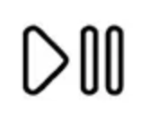
Overview – The start/reload button is denoted by a traditional start and pause symbol (an arrow pointing to the right and two straight parallel lines). This button is used to start the initial wash cycle or pause a cycle as it is running.
Best used for – Starting a wash cycle or stopping a cycle while it’s running.
Benefits/drawbacks – It’s helpful to have the option to stop the washer mid-cycle in case you’ve forgotten to add a few clothing items. You can simply press the reload button, open the door, add your extra items, and continue the wash cycle as normal. However, the reload function is only possible for washes below 50 degrees Celsius.
Childproof Lock
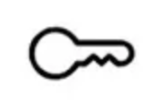
Overview – The child lock symbol is an image of a key. When activated, the child lock disables all of the buttons on the Bosch washing machine.
Best used for – Preventing your child from pressing buttons on your washing machine and accidentally turning it on without you realising.
Benefits/drawbacks – The child lock is an important safety mechanism in every washing machine. It’s only a drawback if you accidentally switch it on and spend ages wondering why none of the buttons on your machine are working!
Washing Symbols
Every Bosch washing machine has a variety of wash programmes. Depending on the model of your washer, you might have some unique settings. However, there are several programmes that you’ll find in pretty much every model, including the following.
Prewash
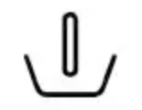
Overview – The prewash programme is shown by a symbol of a long black line with a solid line underneath it. It’s a low-temperature, short cycle that you can use as a standalone feature or at the start of a main wash cycle.
Best used for – Washing clothing that is heavily soiled.
Benefits/drawbacks – This feature is great when you want to thoroughly wash your clothes and get rid of stubborn stains. However, it’s not always necessary if you only need a light wash.
Energy Consumption
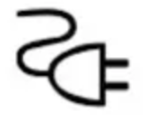
Overview – Similar to the water consumption feature, every Bosch washing machine shows you how much energy a particular wash programme uses per cycle. It’s denoted by an image of a plug with one to five dashes next to it (one being low energy consumption and five being high).
Best used for – Seeing how much energy you’re consuming when you use a particular wash cycle setting.
Benefits/drawbacks – The energy consumption feature is great when you’re trying to cut back on your energy usage in your home (or if you’re curious about how much energy each of your appliance’s wash programs uses). There are no drawbacks!
Water Consumption
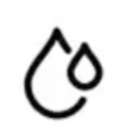
Overview – The water consumption symbol is shown by two water droplets, one a lot smaller than the other. It indicates the total water consumption of the selected wash programme. If water consumption is low, there will be one dash next to the water droplet. High water consumption is shown as five dashes.
Best used for – Identifying how much water a certain wash programme uses.
Benefits/drawbacks – If you’re conscious of the environment and your monthly water expenses, this feature is a great way to help you monitor your water consumption. There are no major drawbacks, and it’s a great feature to have on your washer.
Washing
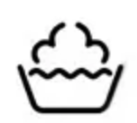
Overview – The washing symbol shows a wash basket with water inside it and steam coming off the top of it. It symbolises the basic wash setting in a Bosch washing machine.
Best used for – General washing cycles.
Benefits/drawbacks – The general washing cycle is probably the setting that you’ll use the most out of all of them because it’s ideal for most clothing items. It may not provide a strong or thorough enough wash if your clothes are heavily soiled. In this case, you may need to run a prewash before a normal wash cycle.
Soaking

Overview – The soaking programme on a Bosch washing machine lasts slightly longer than a normal cycle, meaning the laundry gets an extra soak. It’s denoted by an image of a washing basket filled with a wavy black line.
Best used for – Soaking your clothing if it’s heavily soiled.
Benefits/drawbacks – The soaking feature is ideal when you’re dealing with heavily soiled clothing items, but it’s not necessary for a general wash. It also uses a higher volume of water than a standard wash cycle.
Spin Speed
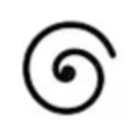
Overview – The spin speed symbol shows a swirl, which refers to a particular program’s spin. You can adjust the spin of your wash cycle using the buttons on your machine.
Best used for – Adjusting the spin of a particular cycle.
Benefits/drawbacks – It’s helpful to adjust the spin of a cycle to make it less or more aggressive, depending on which clothes you’re washing. There are no major drawbacks to having this feature on your washer.
Rinse

Overview – The rinse programme is shown by a wash basket with a number of solid black lines inside it. It’s a common feature found in every Bosch washing machine and gives your laundry an extra rinse.
Best used for – Rinsing your laundry.
Benefits/drawbacks – The rinse programme provides an extra rinse for laundry that’s in need of a more thorough wash. The downside is that this programme will use more water than a standard wash cycle.
Extra Rinse

Overview – The extra rinse symbol is very similar to the rinse symbol, but it has a ‘+’ sign above the wash basket. This programme provides up to three additional rinse cycles compared to a standard wash cycle.
Best used for – Washing your clothing if you have sensitive skin or if you live in regions that have a soft water supply.
Benefits/drawbacks – The extra rinse programme is ideal for ridding your clothes of detergents and chemicals if you have sensitive skin or allergies, but it also uses a lot more water than the washing or rinse programmes.
Rinse Hold

Overview – The rinse hold is a unique function that keeps your laundry in the water after its final rinse cycle. You can activate this feature at the end of your washing cycle. The symbol for this program is shown by a wash basket filled with water.
Best used for – Giving your laundry an extra rinse at the end of a standard wash cycle.
Benefits/drawbacks – The rinse hold feature gives your clothing a more thorough wash, which is ideal if your laundry is stained or soiled. Because your laundry is held in the washer at the end of a full-length cycle, this programme will take longer to complete.
Easy Iron
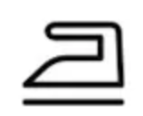
Overview – The easy iron symbol is denoted by an image of an iron. It’s used for the setting in your washer that minimizes creasing on your laundry by adjusting the spin cycle and spin speed appropriately.
Best used for – Washing laundry that creases easily.
Benefits/drawbacks – It’s helpful to have a non-crease, easy-iron option on your washer when you’ve got clothing that creases easily during a normal wash cycle. However, this particular programme might take a little longer to complete, so it’s one to save for when you’ve got more time to do your laundry!
Adding Laundry

Overview – The adding laundry programme is denoted by a symbol of a double-lined circle and a lock. When this symbol turns off during a wash cycle or at the end of a cycle, it indicates that it’s safe to add additional items.
Best used for – Adding more laundry to the washer.
Benefits/drawbacks – If you’ve forgotten to put an item in the washing machine before you turned it on, you will be able to add it to the drum, so you don’t need to wait until you’re next doing your washing. There are no specific drawbacks to this feature.
Silent Wash

Overview – The silent wash is shown by an unforgettable symbol of a pair of lips with a finger covering them (as though the person is ‘shushing’). It’s a feature that you’ll find in a lot of newer Bosch washing machines, and it silences the audible beeping that would usually run at the end of a wash cycle. The final speed is also reduced when the silent wash is activated to reduce the amount of noise that your appliance produces.
Best used for – Washing your clothing when you’ve got guests around or when you live in close proximity to other people and want to reduce noise production when doing your washing.
Benefits/drawbacks – Putting on the silent wash is a lifesaver when you’re trying to minimize your noise production at home. The downside to this feature is that your washer won’t signal to you when the cycle is finished, so you might forget to get your laundry out of the drum.
Intensive Plus

Overview – The intensive plus shows an image of water sprinkles over a semi-circle with a plus sign to the right of it. Your appliance might also have the words ‘intensive plus’ next to the symbol. It’s a feature that extends a standard cycle by up to 30 minutes.
Best used for – Washing heavily soiled laundry.
Benefits/drawbacks – When you’ve got a bunch of soiled laundry, the Intensive Plus programme should be your go-to. It thoroughly washes your clothing for up to 30 minutes extra per cycle to make your items look as good as new. The drawbacks to using this feature include the fact that it will take longer to complete and will use a higher amount of energy and water than a standard washing cycle.
Water Plus

Overview – The water plus symbol shows a wash basked with a large arrow pointing upwards above it. This program is recommended for use when you have sensitive skin or if you’re washing fragile or delicate clothing.
Best used for – Washing laundry when you have sensitive skin or if you don’t want to damage delicate clothing items during the washing process.
Benefits/drawbacks – The water plus feature is perfect if you’re someone who has sensitivities or allergies to particular detergents and fabrics. It’s also great to protect your fragile items that could get damaged during a standard washing cycle. You might only use this feature every so often, but it’s great to have as many options.
AntiStain

Overview – The AntiStain programme in Bosch washing machines doesn’t necessarily have a symbol; it’s denoted by the word ‘AntiStain’. You can use this feature to select a specific type of stain, and the appliance will choose the appropriate temperature, spin, and soaking time.
Best used for – Getting rid of a range of different stains.
Benefits/drawbacks – Having an AntiStain feature on your washer comes in handy when you’ve got seriously soiled laundry and want to clean it quickly. However, you might never end up using this feature if you rarely have soiled or stained washing. You also have little control over how long the cycle is or how much energy it uses because the appliance selects it for you based on the type of stain you select.
i-Dos

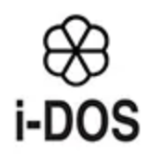
Overview – You can use the i-Dos function to automatically set the detergent dosage before the wash cycle begins or during the prewash before a full cycle. It’s shown by a water droplet and the text ‘i-Dos’ below it. In some Bosch washers, the water droplet is replaced by a flower. The light i-Dos setting is best for lightly soiled laundry, and the heavy setting is best for heavily soiled and stained clothing.
Best used for – Selecting the amount of detergent used in a single cycle.
Benefits/drawbacks – The i-Dos programme minimizes detergent wastage and enables you to control how much detergent is used for particular wash loads. The main drawback is that there are only three settings (light, medium, and heavy), and you might wish for a more extensive range of options. However, for most people, three options are more than enough.
Drum Clean
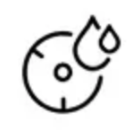
Overview – You’ll find the drum clean programme in almost every Bosch washing machine model. Its symbol is an image of a drum with a couple of water droplets in the top right corner. It’s used to clean the inner compartment of your drum.
Best used for – Cleaning the drum of your washing machine if it’s dirty.
Benefits/drawbacks – It’s helpful to have a drum clean feature to save you from manually wiping over the inside compartment of your appliance. It’s quicker and easier, but it will also use more electrical energy and water than cleaning the drum with a cloth and spray.
Remote Start

Overview – The remote start feature enables you to control your washing machine remotely via an app. The symbol for this is a black rectangle with two network lines in its upper right corner. To use this feature, you’ll need to download the relevant app onto your smartphone and sync it up to your washing machine.
Best uses for – Controlling your appliance remotely.
Benefits/drawbacks – Being able to control your washer remotely is ideal when you’re out of the house and want to come home to freshly cleaned laundry. The downside is that you’ll need to be tech-savvy to use this feature, as it requires the use of a smartphone and an app.
Troubleshooting Symbols
There are a couple of symbols to be aware of when it comes to troubleshooting issues with your Bosch washing machine. The two main symbols are foam detection and low water pressure.
Tap

Overview – The tap symbol will light up when the water pressure inside your washer is too low. This is most commonly caused by a blocked drainpipe or a kink in the supply hose.
Best used for – This isn’t necessarily a program that you use.
Benefits/drawbacks – Low water pressure and blocked drains are safety hazards. Having the tap symbol is important to alert you of these issues so you can resolve them as quickly as possible. There are no drawbacks to this essential safety feature, but it’s definitely a nuisance when you notice that the tap symbol is active! You’ll need to call a Bosch technician to your home to resolve this issue.
Foam Detection
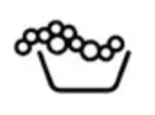
Overview – The foam detection symbol will illuminate when the appliance has detected too much foam during a wash cycle. Using the foam detection feature removes this additional foam by automatically activating an additional rinse after your normal wash cycle.
Best used for – Getting rid of excess foam inside the drum of the washing machine when you’re running a wash cycle.
Benefits/drawbacks – The foam detection feature is a great safety mechanism to have. Using it will prolong the lifespan of your appliance and reduce the of damaging your clothes. However, note that using the foam detection programme will increase the total energy and water consumption of your cycle due to the additional rinse.
Detergent Drawer Symbols
The detergent drawer in Bosch washing machines has just a few key symbols that you need to know about. Your appliance could have slightly different symbols, but you’ll find the following in the majority of models.
A – The A symbol refers to the general liquid detergent tray.
I – The I symbolises where you add detergent for a prewash.
I I – This option is for adding detergent for a main wash. You will also use this function when you’re using bleach, water softener, or stain remover.
Flower – The flower symbol is the area where you and fabric softener or liquid starch. It will have a line to show the maximum level of fabric softener that is safe to add, and you shouldn’t exceed this.
